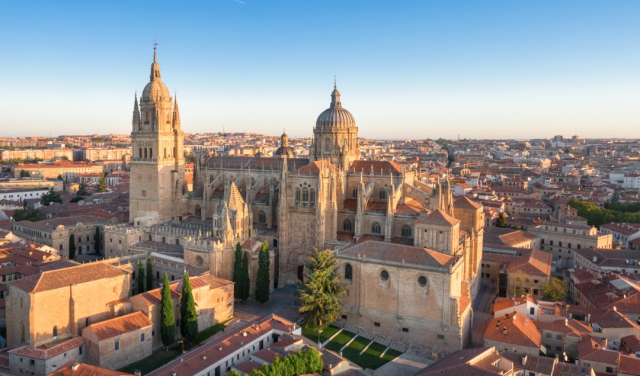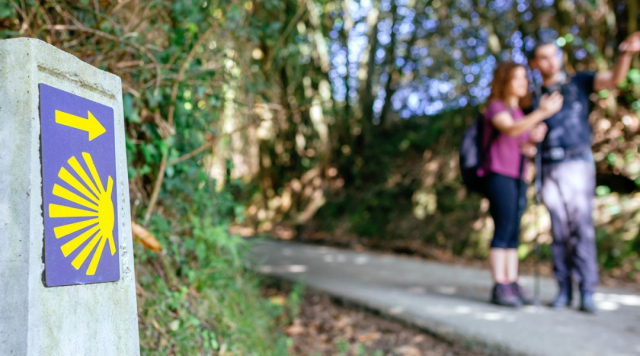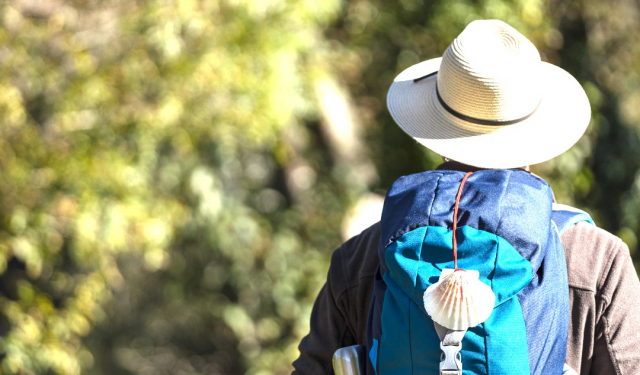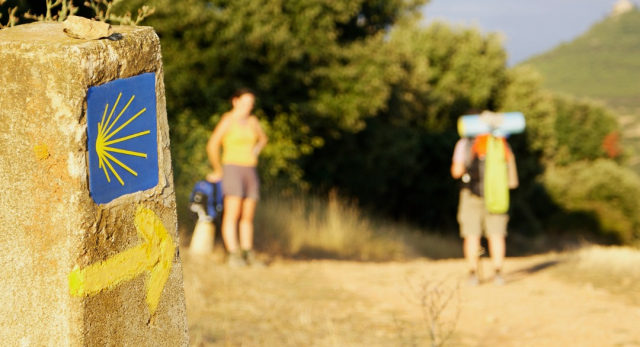Camino de Santiago from Salamanca
Camino de Santiago from
Through the Vía de la Plata and connecting with the French Way, the Camino de Santiago from Salamanca is a long alternative but full of impressive landscapes that will not disappoint the pilgrim.
- Camino de Santiago from Madrid
- Camino de Santiago from León
- Camino de Santiago from Sarria
- Camino de Santiago from Roncesvalles
- Camino de Santiago from A Coruña
- Camino de Santiago from Seville
- Camino de Santiago from Ponferrada
- Camino de Santiago from Burgos
- Camino de Santiago from Ourense
- Camino de Santiago from Bilbao
- Camino de Santiago from Oporto
- Camino de Santiago from Lisboa
- Camino de Santiago from Barcelona
- Camino de Santiago desde Pamplona
- The Camino de Santiago from Irun
- The Camino de Santiago from Astorga
- Camino de Santiago from Valencia
- The Way of Saint James from Saint-Jean-Pied-de-Port
- Camino de santiago from Viana do Castelo
- Doing the Way of Saint James from Zamora
- Doing the Way of Saint James from Zaragoza
- Doing the Way of Saint James from Alicante
- Camino de Santiago from Santander
- Camino Portugués from Coimbra
- Camino de Santiago from San Sebastián
- Camino de Santiago from Vigo: Guide of stages
- Camino de Santiago from Salamanca
- Camino de Santiago from Villafranca del Bierzo
- Camino de Santiago from Pontevedra
- Do the Camino de Santiago from Almería
- Camino de Santiago from Valladolid
- Doing the Way of Saint James from Navarra
Why? do the Camino de Santiago from Salamanca?
At this point, talking about the Camino de Santiago implies delving into something more than a physical or cultural journey, aspects that undoubtedly characterize the pilgrimage. However, the Camino de Santiago is also a route of self-discovery and transformation. Although starting from Salamanca is not the most common option, this starting point is. that offers a unique and unforgettable experience.
The city is busy. It is considered a true treasure of art and history, providing pilgrims with a magnificent starting point. Nestled in the heart of the Vía de la Plata, and one of the Jacobean routes with the most history of the Camino de Santiago, Salamanca has served as a link between the south and north of Spain. The city is a very suitable starting point for the Camino de Santiago and where it is worth stopping before starting the pilgrimage, immersing ourselves in some of the most outstanding moments of our country such as its university, the impressive cathedrals or the Plaza Mayor.
Doing the Camino de Santiago from Salamanca means immersing yourself in a lesser-known Spain, full of surprising landscapes, charming towns and a large number of monuments that are testimony to the past. In addition, as you progress towards Galicia, you will be able to learn more about it. You will experience the evolution of culture, gastronomy and nature, giving you a broader and more diverse vision of the country.
What? to take into account before doing the Camino de Santiago from Salamanca?
As is usual in Vivecamino, before learning about the stages that separate us from our starting point to the arrival at the Cathedral of Santiago, let's see some of the advice that must be taken into account to prepare the trip. Of course, we will delve into them later and in depth.
The first point that you should consider is to know which is the best This is the time to do the Camino de Santiago. It is not the same to start the Jacobean route in winter than in summer, both have their positive points, but more specifically negative ones. In winter we are exposed to a much more aggressive storm in which the wind, cold and rain can make it difficult for us to progress. On the other hand, in summer the temperatures can be a real danger.
To this advice we must also add what? What to carry in your backpack for the Camino de Santiago. The backpack will become your favorite. This will prove to be our best ally during the long days of pilgrimage that lie ahead, so knowing what to do is what to do. including is important without weight being an impediment. Another piece of information that we should not overlook is the one referring to the purchase of < strong>best boots for the Camino de Santiago, an aspect that will depend on what you are looking for. It will largely depend on the time of year chosen.
All the stages of the Camino de Santiago from Salamanca
The Camino de Santiago from Salamanca to Santiago de Compostela, following the route of the Vía de la Plata and the French Way, has approximately 500 kilometers, divided into 18 stages in total. Like any route on the Camino, the exact length may vary slightly depending on the variations of the route or the detours you choose.
- Salamanca - The Wine Land Cube: A 37.2 km stage that crosses farmland and small towns.
- The Cubo de Tierra del Vino - Zamora: With 32.6 km, this stage takes pilgrims to the historic city of Zamora.
- Zamora - Montamarta: 18.6 km stage that leads through the natural reserve of the Esla river reservoirs.
- Montamarta - Granja de Moreruela: This 23.3 km stage passes through the famous Santa Marta de Tera with its Visigothic church.
- Granja de Moreruela - Benavente: A 28.5 km stage that crosses beautiful rural landscapes.
- Benavente - Alija del Infantado: This 24.7 km stage takes pilgrims through farmland and small towns.
- Alija del Infantado - La Bañeza: This 23.5 km stage allows you to enjoy the quiet Spanish rural life.
- La Bañeza - Astorga: With 24.7 km, this stage leads to Astorga, a city known for its cathedral and the Episcopal Palace, the work of Gaudí.
- Astorga - Rabanal del Camino: This 20.4 km stage approaches the mountains of León.
- Rabanal del Camino - Molinaseca: With 24.8 km, this stage includes the crossing of the Cruz de Ferro, the highest point of the Camino de Santiago.
- Molinaseca - Villafranca del Bierzo: This 31.3 km stage leads through the beautiful landscape of El Bierzo.
- Villafranca del Bierzo - O Cebreiro: This 28.8 km stage marks the entry into Galicia and has some steep sections.
- O Cebreiro - Triacastela: With 21 km, this stage offers impressive views of the Galician mountains.
- Triacastela - Sarria: 18.4 km stage through forests and Galician villages.
- Sarria - Portomarin: A 22.2 km section that crosses the river Miño.
- Portomarin - Palas de Rei: This 24.8 km stage crosses through forests and meadows.
- Palas de Rei - Arzúa: This 28.8 km stage is known for its eucalyptus forests and its famous cheese.
- Arzúa - Santiago de Compostela: The last stage of 39.8 km, which takes pilgrims to the famous Cathedral of Santiago de Compostela.
How to walk the Camino de Santiago from Salamanca?
In the same way as the rest of the routes on the Camino de Santiago, there are several ways to travel the journey. Although the most used by the pilgrim continues to be on foot, alternatives such as the bicycle (one of the most used as well) or even by car are other existing ones that you could consider. However, the Camino de Santiago on foot continues to be the option most chosen by the vast majority of pilgrims. In case you finally choose to do the Camino de Santiago by bicycle, remember that unlike the stages on foot you will need to complete a minimum of 200km.
When to do the Camino de Santiago from Salamanca?
As we already mentioned at the beginning of the article, you have to know how to choose what to wear. This time is the best to complete the Camino de Santiago. Winter is a time when cold and rain are quite common, phenomena that could make our progress excessively difficult during the trip. In summer, on the other hand, the high temperatures become a serious problem and with which we must be especially careful.
From ViveCamino we recommend times like autumn or spring. In both cases you will find mild temperatures, stages of influx of pilgrims but without too much congestion in hostels. In both cases, more than enough reasons to value these months as the most interesting to begin our pilgrimage.
Tips for doing the Camino de Santiago from Salamanca
There are many tips for the Camino de Santiago, some universal and that can be adapted to almost any route or pilgrim and others more specific depending on the situation. Be that as it may, here it is. Here you will find all the recommendations you will need to start your trip from Salamanca until you arrive in Santiago.
The physical preparation for the Camino de Santiago is, without a doubt, one of the points that must be taken into account for several months before taking the first step. Regardless of age or physical condition, it is very important that you prepare yourself physically. Keep in mind that you will spend several days in which you will travel hundreds of kilometers through terrain of all kinds. How to prepare? It begins at least 2 or 3 months before the first stage, with walks or hikes of several kilometers. Little by little, introduce different types of terrain into these sessions, adding a few more kilometers and even a backpack with some weight to get your body used to it.
And speaking of backpacks, you've probably been wondering what the backpack is. type of luggage you should take with you. In this sense, there is no written rule, although the most common is to have luggage that represents 10% of your body weight. More than enough to be able to move without problems and without suffering back and shoulders.
Do not forget everything related to footwear. Having good boots for the Camino de Santiago is little more than crucial, comparable to physical condition. They will be your best travel companions so do not be afraid to invest money in this garment. Depending on the time of year you have chosen to do the Camino de Santiago, you should opt for a mountain boot (winter) or a mountain shoe (summer). Of course, in any case, try to make the sole resistant to all types of terrain, breathable and resistant.
- Camino de Santiago from Madrid
- Camino de Santiago from León
- Camino de Santiago from Sarria
- Camino de Santiago from Roncesvalles
- Camino de Santiago from A Coruña
- Camino de Santiago from Seville
- Camino de Santiago from Ponferrada
- Camino de Santiago from Burgos
- Camino de Santiago from Ourense
- Camino de Santiago from Bilbao
- Camino de Santiago from Oporto
- Camino de Santiago from Lisboa
- Camino de Santiago from Barcelona
- Camino de Santiago desde Pamplona
- The Camino de Santiago from Irun
- The Camino de Santiago from Astorga
- Camino de Santiago from Valencia
- The Way of Saint James from Saint-Jean-Pied-de-Port
- Camino de santiago from Viana do Castelo
- Doing the Way of Saint James from Zamora
- Doing the Way of Saint James from Zaragoza
- Doing the Way of Saint James from Alicante
- Camino de Santiago from Santander
- Camino Portugués from Coimbra
- Camino de Santiago from San Sebastián
- Camino de Santiago from Vigo: Guide of stages
- Camino de Santiago from Salamanca
- Camino de Santiago from Villafranca del Bierzo
- Camino de Santiago from Pontevedra
- Do the Camino de Santiago from Almería
- Camino de Santiago from Valladolid
- Doing the Way of Saint James from Navarra
Routes
Blog
 How to get to Sarria to do the Camino de Santiago
How to get to Sarria to do the Camino de Santiago
 Descubre la magia del Camino de Santiago Portugués por la costa
Descubre la magia del Camino de Santiago Portugués por la costa
 5 tours culturales que puedes hacer en Galicia si decides hacer un alto en el camino
5 tours culturales que puedes hacer en Galicia si decides hacer un alto en el camino
 Doing the Camino de Santiago in June: What you should know?
Doing the Camino de Santiago in June: What you should know?
Information
Points of interest
Cities & Towns | Hostels | Lodgings | Restaurants | Saddlery | Doctors | Points of interest | Bikes workshop
Contact us | Privacy policy | Cookies policy | | Terms of use | Authorship | Web Map | Consentimiento
© Copyright LA VOZ DE GALICIA S.A. Polígono de Sabón, Arteixo, A CORUÑA (ESPAÑA) Inscrita en el Registro Mercantil de A Coruña en el Tomo 2438 del Archivo, Sección General, a los folios 91 y siguientes, hoja C-2141. CIF: A-15000649
Developed and managed byHyliacom



